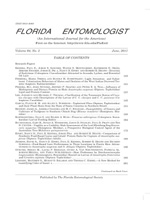Geoica utricularia (Passerini) is known as a species that alternates between galls on Pistacia and the roots of Gramineae, and occasionally Cyperaceae (Blackman & Eastop 1985). Its distribution has been recorded as Morocco, Europe, the Middle East, Central Asia and North America (Blackman & Eastop 1985). In 2009, we observed severe attacks of G. utriculariae on wheat and barley in Manouba and Cap-Bon regions in Northeast Tunisia. Previously, G. utriculariae had been captured in suction traps in the same region (Boukhris-Bouhachem et al. 2007).
Very few insects have been reported to feed on Orobanche (Orobanchaceae). The case of Phytomyza orobanchia Kalt. (Diptera: Agromyzidae) has been reported (Linke 1990; Klein & Kroschel 2002), and Zermane et al. (2001) found Smicronyx cyaneus Gyll. (Coleoptera: Curculionidae) on Orobanche foetida Poir. in Tunisia. Holman (2009) reported Smynthurodes betae WestWood (Hemiptera: Aphididae) on 3 Orobanche species (O. aegyptiaca, O. crenata and O. variegata).
Populations of aphids were found on the subterranean parts, and feeding on spikes of two broomrape plants, Orobanche foetida, attached to faba bean (Vicia faba L.) in May 2010 in a field located at Ariana (36°47′ 57′N, 10°10′32′E). Samples of aphids were collected and prepared for microscopic examination in Canada balsam. They were identified using the Remaudière & Seco Fernandez (1990) and Blackman & Eastop (2000) keys, and also submitted for confirmation to Jon H. Martin at the Natural History Museum in London, UK. Aphid specimens in the colony were white cream, lightly dusted with wax, and broadly oval (Fig. 1). The aphids were identified as G. utricularia (Fig. 2) (determination confirmed by J. H. Martin) and compared favorably with specimens in the museum collection from Morocco and elsewhere. Voucher specimens were deposited at the British museum.
To our knowledge, no associations of this aphid species have been reported previously on Orobanche foetida, so even if the species identification is suspect due to the unusual host range, it represents a host range expansion for the genus. Broomrape infestations are increasing in different regions of Tunisia (Kharrat et al. 2004). Heretofore, the association between G. utriculariae and Orobanche has not been reported, and it is quite curious because the aphids normally feed on Gramineae except when forming galls on Pistaca. A supplementary study will be conducted to determine if aphids can reduce seed production of Orobanche.







